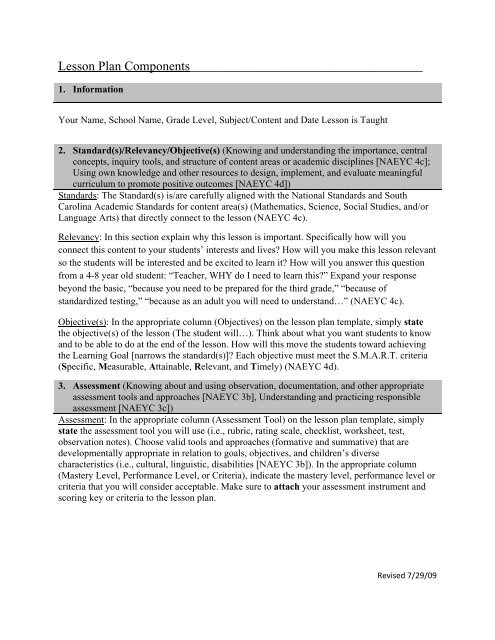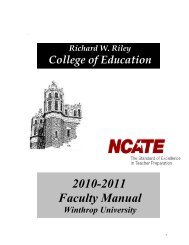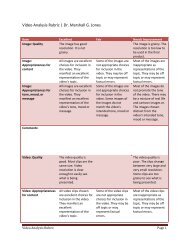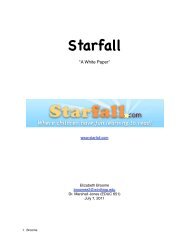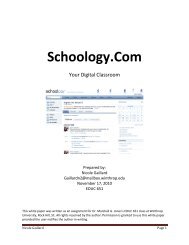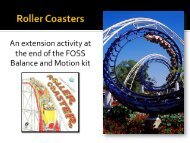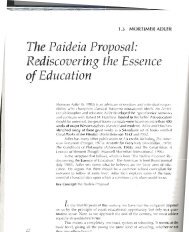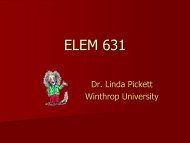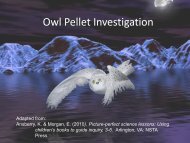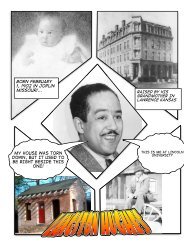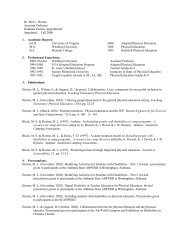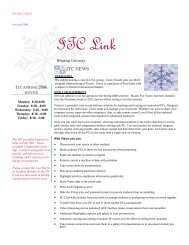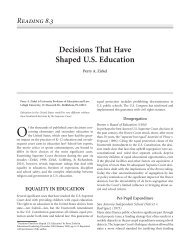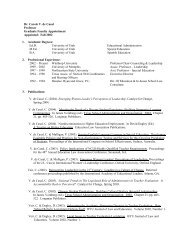Lesson Plan Components
Lesson Plan Components
Lesson Plan Components
You also want an ePaper? Increase the reach of your titles
YUMPU automatically turns print PDFs into web optimized ePapers that Google loves.
<strong>Lesson</strong> <strong>Plan</strong> <strong>Components</strong>____________________________________<br />
1. Information<br />
Your Name, School Name, Grade Level, Subject/Content and Date <strong>Lesson</strong> is Taught<br />
2. Standard(s)/Relevancy/Objective(s) (Knowing and understanding the importance, central<br />
concepts, inquiry tools, and structure of content areas or academic disciplines [NAEYC 4c];<br />
Using own knowledge and other resources to design, implement, and evaluate meaningful<br />
curriculum to promote positive outcomes [NAEYC 4d])<br />
Standards: The Standard(s) is/are carefully aligned with the National Standards and South<br />
Carolina Academic Standards for content area(s) (Mathematics, Science, Social Studies, and/or<br />
Language Arts) that directly connect to the lesson (NAEYC 4c).<br />
Relevancy: In this section explain why this lesson is important. Specifically how will you<br />
connect this content to your students’ interests and lives? How will you make this lesson relevant<br />
so the students will be interested and be excited to learn it? How will you answer this question<br />
from a 4-8 year old student: “Teacher, WHY do I need to learn this?” Expand your response<br />
beyond the basic, “because you need to be prepared for the third grade,” “because of<br />
standardized testing,” “because as an adult you will need to understand…” (NAEYC 4c).<br />
Objective(s): In the appropriate column (Objectives) on the lesson plan template, simply state<br />
the objective(s) of the lesson (The student will…). Think about what you want students to know<br />
and to be able to do at the end of the lesson. How will this move the students toward achieving<br />
the Learning Goal [narrows the standard(s)]? Each objective must meet the S.M.A.R.T. criteria<br />
(Specific, Measurable, Attainable, Relevant, and Timely) (NAEYC 4d).<br />
3. Assessment (Knowing about and using observation, documentation, and other appropriate<br />
assessment tools and approaches [NAEYC 3b], Understanding and practicing responsible<br />
assessment [NAEYC 3c])<br />
Assessment: In the appropriate column (Assessment Tool) on the lesson plan template, simply<br />
state the assessment tool you will use (i.e., rubric, rating scale, checklist, worksheet, test,<br />
observation notes). Choose valid tools and approaches (formative and summative) that are<br />
developmentally appropriate in relation to goals, objectives, and children’s diverse<br />
characteristics (i.e., cultural, linguistic, disabilities [NAEYC 3b]). In the appropriate column<br />
(Mastery Level, Performance Level, or Criteria), indicate the mastery level, performance level or<br />
criteria that you will consider acceptable. Make sure to attach your assessment instrument and<br />
scoring key or criteria to the lesson plan.<br />
Revised 7/29/09
4. Materials/Resources/Equipment/References (Using own knowledge and other resources to<br />
design, implement, and evaluate meaningful, challenging curriculum to promote positive<br />
outcomes [NAEYC 4d])<br />
Materials/Resources/Equipment/References: List all the materials/resources/equipment you will<br />
use in the lesson (NAEYC 4d). Be sure to include copies of the materials and/or resources you<br />
will use (worksheets, word lists, game directions, etc.). Describe materials/resources/equipment<br />
that cannot be included with the lesson plan (books, articles, video title, SmartBoard, etc.).<br />
References are cited using APA. DO NOT use another person’s ideas or words without citing the<br />
source). Borrowed material must not appear to be your original work.<br />
5. Effective Instructional Approaches, Strategies, or Tools (Knowing, understanding, and<br />
using positive relationships and supportive interactions [NAEYC 4a], Knowing,<br />
understanding, and using effective approaches, strategies, and tools for early education<br />
[NAEYC 4b], Knowing and understanding the importance, central concepts, inquiry tools,<br />
and structures of content areas or academic disciplines [NAEYC 4c])<br />
Introduction to lesson: Describe how you will “hook” or grab the learner? How will you activate<br />
students’ prior knowledge? The introduction should only last about 2-3 minutes. Be sure to<br />
provide a time estimate (NAEYC 4b, c)!<br />
Procedures: This is the “meat” of the plan and should match objectives. Include enough detail so<br />
that anyone could follow your plan. Include curricular structures or (instructional) strategies<br />
(i.e., whole class, small group, individuals) to address your objectives. Remember to be very<br />
specific in this section. Make connections clear to students. How does all the information fit<br />
together? Get whatever is in your head on paper! Make sure the CONTENT is EVIDENT!! Be<br />
sure to provide a time estimate (NAEYC 4c)!<br />
Closure: You should summarize the lesson and if appropriate, provide a transition to the next<br />
lesson. How will you wrap up for the day and provide one last opportunity for students to<br />
process the day’s lesson? Closure should take about 5 minutes or less. Be sure to provide a time<br />
estimate (NAEYC 4c)!<br />
Transitions: Include transitions (that are connected to the lesson if possible) to stimulate student<br />
interest (NAEYC 4a). Be sure to provide a time estimate!<br />
6. Modifications and/or Accommodations/Extensions (Understanding and practicing<br />
responsible assessment [NAEYC 3c], Knowing, understanding, and using effective<br />
approaches, strategies, and tools for early education [NAEYC 4b], Knowing, understanding,<br />
and using appropriate, effective approaches and strategies for early education [NAEYC 4d])<br />
Modifications/Accommodations/Extensions: EVERY class has learners of differing abilities and<br />
needs (refer to contextual factors information) so make sure you address them here and be childspecific<br />
(NAEYC 4d). Modifications/Accommodations/Extensions will detail how you will<br />
change the materials, procedures, or assessment (NAEYC 3c) to make sure you address all of the<br />
needs of individual students in your classroom (i.e., special education, ELL, below grade level,<br />
gifted/talented, early finishers). Describe modifications and/or accommodations, and extensions<br />
that you will include. Extensions refer to additional activities (that relate to concepts being<br />
Revised 7/29/09
explored) for students who finish early and/or to challenge their critical thinking skills (NAEYC<br />
4b).<br />
7. Analysis of Student Learning – Reflect AFTER you teach your lesson (Knowing about and<br />
using observation, documentation, and other appropriate assessment tools and approaches<br />
[NAEYC 3b]; Understanding and practicing responsible assessment [NAEYC 3c])<br />
Analysis of Student Learning: In narrative form, discuss what you learned about your students.<br />
How did you know if lesson objectives were attained and by whom? Base your analysis on<br />
specific student data (i.e., scoring rubrics, checklists, observations, interviews, worksheets, etc.).<br />
Quantify the results and analyze and discuss the data. Make sure to address which objectives<br />
were met and to what extent. Also address those objectives not met and how this will inform<br />
your instruction. Note the content that should be re-taught and to whom. What would you change<br />
to increase student learning, especially in lower performing students? How did you provide<br />
enrichment to extend student learning?<br />
8, Reflection – Reflect AFTER you teach your lesson (Knowing, understanding, and using<br />
positive interactions and supportive interactions [NAEYC 4a]; Knowing and understanding the<br />
importance, central concepts, inquiry tools, and structures of content areas or disciplines<br />
[NAEYC 4c]; Using own knowledge and other resources to design, implement, and evaluate<br />
meaningful, challenging curriculum to promote positive outcomes [NAEYC 4d]; Integrating<br />
knowledgeable, reflective, and critical perspectives on early education [NAEYC 5d])<br />
Reflection: In narrative form, discuss what you learned from teaching the lesson. What went well<br />
(or not)? How were challenging behaviors addressed? How were children’s individual<br />
characteristics, needs and interests taken into account? What could you have done differently?<br />
How effective were the curricular structures and/or instructional strategies used in the lesson?<br />
Would another curricular structure and/or instructional strategy have a greater impact on student<br />
learning? Explain. What did you learn about yourself as a teacher? Lastly, identify areas for your<br />
professional growth and resources that you might use to gain deeper understandings.<br />
Revised 7/29/09


